BELL TARGET SHOOTING
The Equipment: the target
One of the first targets was a square metal plate, painted with
whitewash to show the pellet strike. But what rapidly became the
accepted and most used target was the Bell Target, a metal device that
replaced the square plate, with a 3/8th aperture drilled in the centre
of the target, behind which was a bicycle bell. The bell gave an audible
"ding" when a pellet passed through the hole in the steel face plate.
|
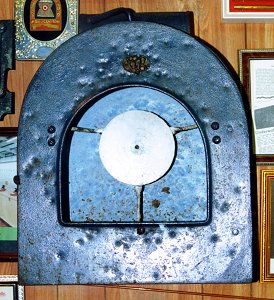
A 1910 vintage bell target. |
The Bell Target was usually surrounded by a metal case. The metal was
hard enough to flatten the pellet on impact, so the pellet fell straight
down onto the floor of the casing. Ricochets were rare, only occurring
when the pellet struck the edge of the metal plate; in those cases the
casing caught the pellet.
The target was lit by a candle or gas jet
depending on the location, as some country areas did not then have gas. |
| A bell target is opened to show the
interior. The white disc is the target with the bull
aperture just visible, with the bell immediately behind it.
At the top the inverted T-shaped bar is
the gas pipe which, when lit, provided illumination for the
target. |
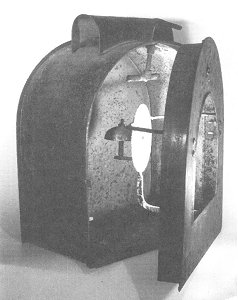
|
| Sometimes a "split shot" could not be heard if a small fragment only
struck the bell. This caused some problems for the scorers and so a more
advanced target was made. This was the universally accepted "cocking"
version. A chain, or length of sash cord, hanging down below the target,
when pulled, cocked and held the mechanism until the pellet, striking a
plunger behind the centre hole, released a hammer against the bell,
giving a much louder "ding". |
|
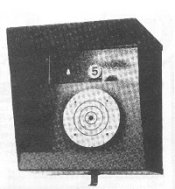
|
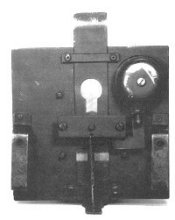
|
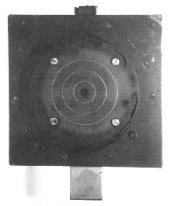
|
|
Cocking version of the bell target. |
| Today's targets are much more advanced, being electrically lit, and in
some models a timed buzzer replaces the bell. These targets are a far
cry from the days when a bell target could be purchased from the firm of
C. H. Ross & Co of Barrow Street, West Bromwich, for as little as one
shilling and sixpence, or a top of the range version for ten shillings -
50p in today's money. The method of scoring was by graduations engraved on the face plate,
recording a five scored for a centre shot, then four, three, two and
one, for shots going away from the aperture. Six shots per shooter was
the normal practice, and for anyone scoring a 30, a real gold medal was
awarded.
|
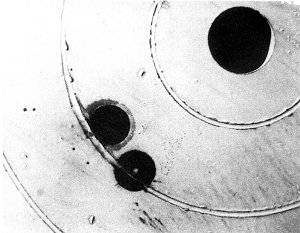 |
Close up of the face of the target plate, showing the bull
aperture and the engraved circles for scoring.
The upper black
mark on the left is the strike from a flat headed paper target pellet.
The lower black mark is the strike from a round nosed bell target
pellet, showing the dot left in the centre. |
| A rather unique way of determining the pellet strike for
match scoring was by coating the face plate with a non-drying
white paint. This replaced the old whitewash system which was
discarded as messy and not quite so readable. |
| The paint, made up from white paint powder and castor oil,
is still the accepted way of scoring the bell target today.
Nothing has been found that would do the job better.
The .177 calibre round nosed slug and the wasted pellet, gave a clear indication of the point
of impact by leaving a clear dot in the centre of the strike. After each
shot had been duly recorded, this mark and dot would be dabbed out with
a small brush, ready for the next shot.
Bell targets were manufactured by several companies. I have one with a
battered brass badge, on the front of the large metal door, that bears
the title "Lincoln Target". It was originally lit by two naked jet gas
lights, or a candle. It is non-mechanical, with the bell and plate fixed
to the opening door - a treasured unit that gave much service to the
Bridgnorth Salop Airgun League. |
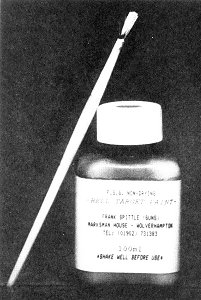
Bell target paint and marker's brush for removing the
strike marks after each shot. |
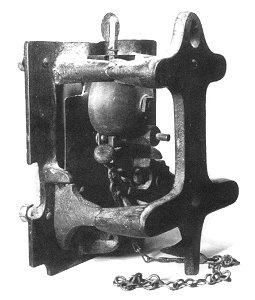 |
A heavy 1920 bell target, showing working parts.
Made by Cox & Sons, Weaman Street, Birmingham. |
| Another is a massive target made by the firm of Cox and Sons, Weaman
Street, Birmingham. This one has a little story to it.
Mr Harry Wedgebury, a dedicated air rifle shooter and former committee member of
the former National Air Rifle and Pistol Association (N.A.R.P.A.), was
in conversation with an old workmate in 1960, about the licensed house
bell target shooting between the wars and following World War Two.
He
told young Harry that he had shot for the Army and Navy pub on the
corner of Great Brook Street. "They are just pulling it down" he said.
"The guns were kept locked up in a cupboard by the fireplace in the bar.
You never know, they could still be there." |
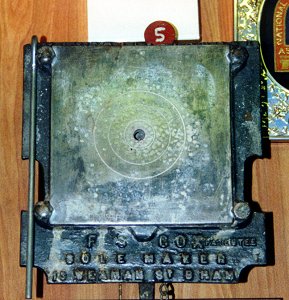
The front of the heavy target rescued by Harry
Wedgebury from the Army and Navy pub, Great Brook Street, Birmingham. |
| Hot-foot, our enthusiast sped to the pub only to find it derelict. The
doors of the cupboard were hanging open with the gun racks still in
place but empty. It had been a long shot and as he left the rubbish
strewn bar room, he kicked an old rusty biscuit tin, which split open to
reveal the old Bell Target. How many matches had this old friend seen
through its single aperture eye? How many shooters and the sons of
shooters, going out to two world wars, were never to hear again "Ding",
"Five scored", "Correct". Now in happy retirement, hard shots giving a
mark of character to its battered face, with years of dust and white
paint clinging to its working parts, it seems a shame to clean its
spirit from it, so it remains as found, shoulder to shoulder with the
most advanced target rifles in the world, and flanked by two stately
Lincoln Jefferies B.S.A. rifles. |
 |
|
 |
Return to the
previous page |
|
Proceed to the
next page |
|









